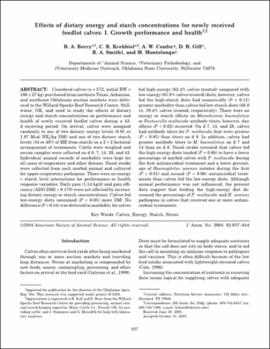| dc.contributor.author | Berry, B. A. | |
| dc.contributor.author | Krehbiel, C. R. | |
| dc.contributor.author | Confer, A. W. | |
| dc.contributor.author | Gill, D. R. | |
| dc.contributor.author | Smith, R. A. | |
| dc.contributor.author | Montelongo, M. | |
| dc.date.accessioned | 2015-10-16T20:47:55Z | |
| dc.date.available | 2015-10-16T20:47:55Z | |
| dc.date.issued | 2004 | |
| dc.identifier | okds_Confer_JAS_2004.pdf | |
| dc.identifier.citation | Berry, B. A., Krehbiel, C. R., Confer, A. W., Gill, D. R., Smith, R. A., & Montelongo, M. (2004). Effects of dietary energy and starch concentrations for newly received feedlot calves: I. Growth performance and health. Journal of Animal Science, 82(3), 837-844. https://doi.org/10.2527/2004.823837x | |
| dc.identifier.uri | https://hdl.handle.net/11244/19815 | |
| dc.description.abstract | Crossbred calves (n = 572; initial BW = 186 +/= 27 kg) purchased from northern Texas, Arkansas, and southeast Oklahoma auction markets were delivered to the Willard Sparks Beef Research Center, Stillwater, OK, and used to study the effects of dietary energy and starch concentrations on performance and health of newly received feedlot calves during a 42-d receiving period. On arrival, calves were assigned randomly to one of two dietary energy levels (0.85 or 1.07 Mcal NEg/kg DM) and one of two dietary starch levels (34 or 48% of ME from starch) in a 2 X 2 factorial arrangement of treatments. Cattle were weighed and serum samples were collected on d 0, 7, 14, 28, and 42. Individual animal records of morbidity were kept for all cases of respiratory and other disease. Nasal swabs were collected from each morbid animal and cultured for upper-respiratory pathogens. There were no energy x starch level interactions for performance or health response variables. Daily gain (1.14 kg/d) and gain efficiency (ADG:DMI = 0.179) were not affected by increasing dietary energy or starch concentrations. Calves fed low-energy diets consumed (P < 0.05) more DM. No difference (P = 0.54) was detected in morbidity for calves fed high-energy (62.4% calves treated) compared with low-energy (65.8% calves treated) diets; however, calves fed the high-starch diets had numerically (P = 0.11) greater morbidity than calves fed low-starch diets (68.8 vs. 59.4% calves treated, respectively). There were no energy or starch effects on Mannheimia haemolytica or Pasteurella multocida antibody titers; however, day effects (P < 0.02) occurred. On d 7, 14, and 28, calves had antibody titers for P. multocida that were greater (P < 0.05) than titers on d 0. In addition, calves had greater antibody titers to M. haemolytica on d 7 and 14 than on d 0. Nasal swabs revealed that calves fed the high-energy diets tended (P = 0.06) to have a lower percentage of morbid calves with P. multocida during the first antimicrobial treatment and a lower percentage of Haemophilus somnus isolates during the first (P = 0.01) and second (P = 0.06) antimicrobial treatments than calves fed the low-energy diets. Although animal performance was not influenced, the present data suggest that feeding the high-energy diet decreased the percentage of P. multocida and H. somnus pathogens in calves that received one or more antimicrobial treatments. | |
| dc.format | application/pdf | |
| dc.language | en_US | |
| dc.publisher | American Society of Animal Science | |
| dc.rights | This material has been previously published. In the Oklahoma State University Library's institutional repository this version is made available through the open access principles and the terms of agreement/consent between the author(s) and the publisher. The permission policy on the use, reproduction or distribution of the material falls under fair use for educational, scholarship, and research purposes. Contact Digital Resources and Discovery Services at lib-dls@okstate.edu or 405-744-9161 for further information. | |
| dc.title | Effects of dietary energy and starch concentrations for newly received feedlot calves: I. Growth performance and health | |
| osu.filename | okds_Confer_JAS_2004.pdf | |
| dc.description.peerreview | Peer reviewed | |
| dc.identifier.doi | 10.2527/2004.823837x | |
| dc.description.department | Animal Science | |
| dc.description.department | Veterinary Pathobiology | |
| dc.description.department | Veterinary Medicine Outreach | |
| dc.type.genre | Article | |
| dc.type.material | Text | |
| dc.subject.keywords | calves | |
| dc.subject.keywords | energy | |
| dc.subject.keywords | starch | |
| dc.subject.keywords | stress | |
